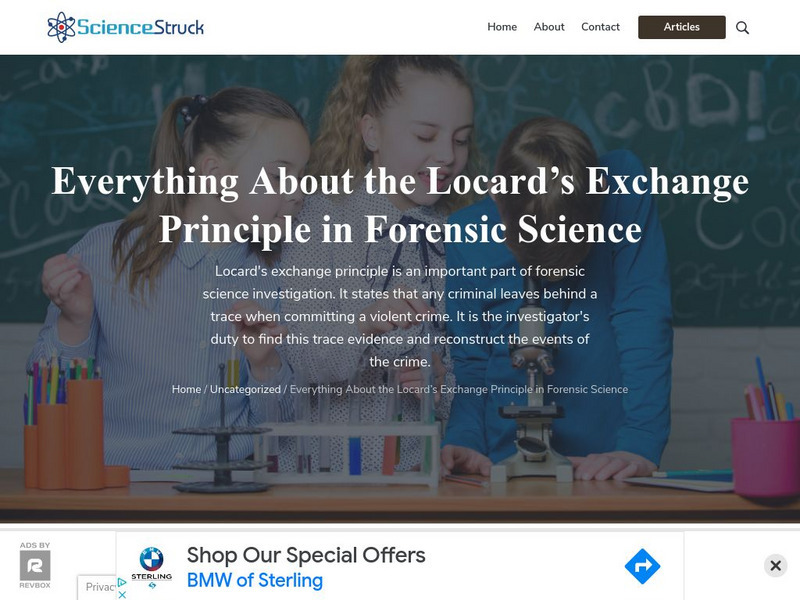Science Struck
Science Struck: Unique Facts About Albert Einstein
Profiles the life and accomplishments of Albert Einstein.
Science Struck
Science Struck: Understanding the Ocean Ecosystem
Describes the two organisms capable of photosynthesis in an ocean ecosystem, the different ocean zones and the plants and animals that live in them, some facts about the ocean, and the five oceans of the world.
Science Struck
Science Struck: Plastic Wars: Thermoplastics vs. Thermosets
Explains what thermoplastics and thermosets are, their properties, and their advantages and disadvantages. Provides lots of examples for each of how they are used in everyday life.
Science Struck
Science Struck: Locard's Exchange Principle in Forensic Science
'This resource describes some of the history of forensic science and what Locard's Exchange Principle is and how it is applied. Discusses the different types of trace evidence that investigators look for and some drawbacks of Locard's...
Science Struck
Science Struck: What Are the 7 Continents
Provides short descriptions of the characteristics of each of the seven continents, along with maps.
Science Struck
Science Struck: Step by Step Guide to the Zinc Electroplating Process
Explains what zinc electroplating is, its uses, how it is done, and its advantages and limitations.
Science Struck
Science Struck: Types of Alloys and Their Uses
Looks at the composition and uses of three types of metal alloys - stainless steel, brass, and sterling silver.
Science Struck
Science Struck: Different Types of Alloys
Explains what an alloy is and lists common alloys along with their base metals.
Science Struck
Science Struck: Flora and Fauna of the Ordovician Period
Describes plants and animals that lived during the Ordovician Period, where it falls in the geologic time scale, tectonic activity happening then, the climate and environment, and extinction events.
Science Struck
Science Struck: Mesozoic Era Timeline and Important Facts
Provides an overview of the Mesozoic Era, its time frame, geological and tectonic activities, the climate, plants and animals, and extinction events towards the end of this era.
Science Struck
Science Struck: The Meaning of Index Fossils Explained
Explains the importance of index fossils for the dating and chronology of events in the fossil and geological records. Discusses uses and examples of index fossils in the Cenozoic, Mesozoic, and Paleozoic Eras.
Science Struck
Science Struck: What Are Stromatolites and How Do They Form?
Explains what stromatolites are, their formation from colonies of cyanobacteria, their evolutionary importance, and where they can be found living today. Thrombolites are similar to stromatolites but form differently. They can also still...
Science Struck
Science Struck: What Causes Monsoons
Explains what monsoons are, what causes them, and the impact they have.
Science Struck
Science Struck: Explanation of an Occluded Front With Diagram
Explains what an occluded front is and how it forms when three air masses interact.
Science Struck
Science Struck: Salt Crystallization
Learn how salt crystallizes and the weathering effect that this has on rocks and on structures.
Science Struck
Science Struck: Definition of Climax Community With Examples
Explains how a climatic community is the end product of ecological succession and describes the process by which this happens. Provides several examples of climax communities.
Science Struck
Science Struck: Ionosphere Facts
Learn facts about the ionosphere. It is an extension of the thermosphere, one of the five layers of the atmosphere.
Science Struck
Science Struck: Examples of Primary Consumers in the Food Chain
Explains what a primary consumer's role in a food chain is and provides examples.
Science Struck
Science Struck: Nitrogen in the Atmosphere
Learn about the properties of nitrogen, how it was first formed, where it is found, and the importance of the nitrogen cycle.
Science Struck
Science Struck: What Is Graded Bedding?
Explains what graded bedding is and how it forms in sedimentary deposits.
Science Struck
Science Struck: Devices Used to Measure Angles
Looks at the many devices used to measure angles in academic settings and in real-world settings.
Science Struck
Science Struck: Types of Skewed Distribution With Real Life Examples
Explains what is meant by a skewed distribution, describes the two types, and gives examples.
Science Struck
Science Struck: Visible Color Spectrum Wheel
A brief explanation of the visible color wheel.
Science Struck
Science Struck: Color Spectrum Chart With Frequencies and Wavelengths
Read about the visible light spectrum and learn the frequencies and wavelengths for each of the primary and secondary colors.



